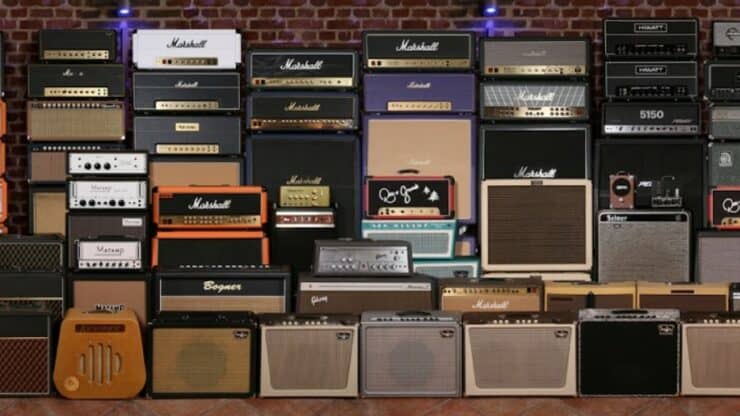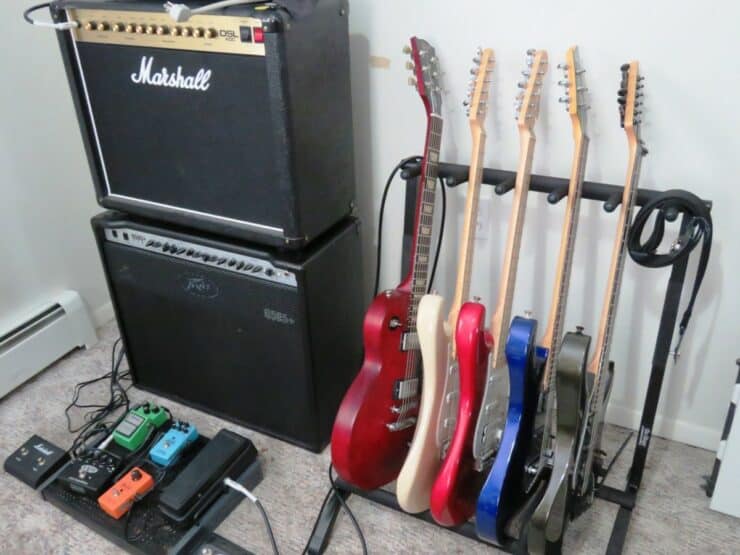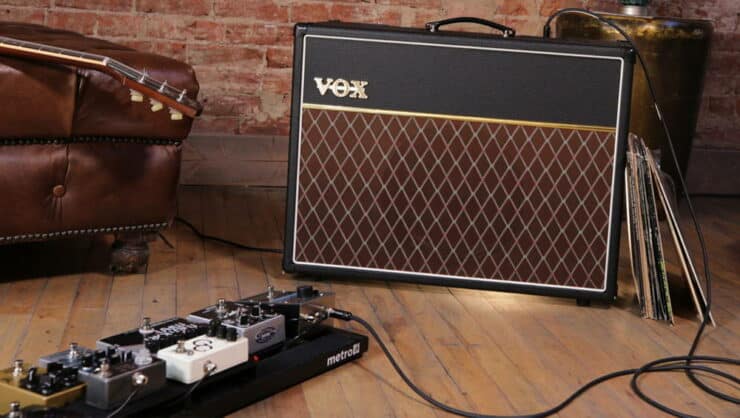If you’re a guitarist, and you’re looking for the perfect tone, then you’re likely in search of the perfect amp. But what kind of amp should you get? Is it worth investing in a tube amp, or is a digital modeling amp more suitable for your needs? In this article, we’ll take a look at the differences between tube and modeling amps and how they can help you get the sound you’re after. Read on to find out which type of amp will work best for you.
Overview of tube amps
Tube amps or also known as valve amplifiers are electronic devices used for amplifying audio signals. These types of guitar amps are known for their warm, rich sound and are typically used in professional audio applications and by audiophiles, musicians, and guitarists. It works by passing an audio signal through a preamplifier tube, which boosts the signal’s voltage, and then through a power amplifier tube, which increases the signal’s power.
The different components of tube amps are –
#1. Vacuum tubes or valves
The vacuum tubes or valves are the heart of a tube amp. They are essentially glass or metal tubes with electrodes inside to conduct electricity. When heated, the electrons move between the electrons, creating a flow of charge that amplifies the audio signal.
#2. Power supply
The power supply is responsible for providing the necessary voltage and current to the vacuum tubes. It’ll convert the alternating current (AC) from the power outlet into the direct current (DC) normally needed by the amplifier.
>>> Click here to read our review about the Top 15 Best Tube Amps <<<
#3. Preamp
The preamp is the first stage of the tube amp, and it is responsible for amplifying the incoming audio signal. It typically has numerous tubes and can be adjusted to control the sound’s tonal quality.
#4. Power amp
The power amp is the second stage of the amp, and it is responsible for providing the necessary power to drive the speakers. It typically comes with one or more tubes, and they can be adjusted for controlling the sound’s volume and distortion.
#5. Output transformer
The output transformer will be responsible for matching the impedance of the amplifier to the speaker’s impedance. It is a critical component of the amplifier, and it can greatly affect the sound’s tonal quality.
#6. Capacitors and resistors
Capacitors and resistors are used throughout the tube amp to control the flow of the current and shape the tonal quality of the sound. They are important components that help fine-tune the tube amp’s performance.

Overview of modeling amps
Modeling amps, on the other hand, are a type of guitar amp that utilizes digital technology for emulating the sound of various classic and modern amps. They have become a popular choice among musicians who are looking for a wide range of sounds from a single guitar amp.
This electronic amp uses Digital Signal Processing (DSP) technology for simulating the sound of various classic and modern amps. It allows musicians to recreate the sound of different amps and effects without requiring multiple amplifiers and pedals.
The different components of digital amps are –
#1. Digital Signal Processor
The Digital Signal Process is the heart of a modeling amp. It is typically responsible for processing the audio signal and simulating the sound of different amplifiers and effects.
#2. Amplifier models
The amplifier models are the various-simulated amplifier sounds that are available on the modeling amp. They can range from classic tube amps to modern solid-state amps, and can be easily adjusted to control the sound’s tonal quality.
#3. Effects models
The effects models are the different-simulated effects that are available on the modeling amp. They can include distortion, chorus, reverb, and delay, among others. You can easily adjust them to control the sound’s tonal quality.
#4. Speaker models
The speaker models are the different-simulated speaker sounds that are available on the modeling amp. They can range from vintage to modern speaker sounds and can be easily adjusted to control the sound’s tonal quality.
#5. Input and output jacks
The input and output jacks are where the audio signal will get connected to the modeling amp. The input jack is where the guitar or other audio source is connected, whereas the output jack is where the amp is connected to the speakers.
#6. Control knobs and switches
The control knobs and switches are used for adjusting different settings on the modeling amp. These can include volume, gain, tone, and effects controls among others.
Benefits of tube amps
Tube amps are arguably the most popular and widely used type of guitar amps among musicians, guitarists, and audiophiles, and this has been the case for many years. These amps are capable of offering splendid sound and unique tonal qualities. However, there are many other benefits to these amps as well. Here are some of the benefits of tube amps –
#1. Warm and natural sound
Tube amps are known for their warm and natural tone, which is a result of the way the vacuum tubes amplify the audio signal. This unique sound is quite difficult to replicate with other types of amps, and many musicians and guitarists prefer the sound of tube amps.
#2. Wide dynamic range
Tube amps are capable of offering a wide dynamic range, which means that they can produce both loud and soft sounds with greater clarity and detail compared to other types of amps. This is especially important for guitarists and musicians who play music with a wide range of dynamics, like jazz or classical music.
#3. Unique distortion
Tube amps offer a unique type of distortion that many musicians and guitarists find desirable. This distortion is often described as “warm” and “creamy” and it can add character and depth to the sound.
#4. Highly customizable
Tube amps tend to be highly customizable, and many musicians and guitarists enjoy experimenting with different tubes and components to achieve their desired sound. This level of customization is not possible with other types of amps, which typically come with fixed components.
#5. Durability
Tube amps are widely known for their durability and long lifespan. Unlike other types of amps, which often have components that have to be replaced from time to time, tube amps can last for decades with proper maintenance.
#6. Versatility
Tube amps are extremely versatile and can be used in a wide range of applications, from live performances to recording studios. They can be easily adjusted to control the sound’s tonal quality and can produce a wide range of sounds, from clean tones to heavily distorted tones.

Benefits of modeling amps
Since modeling amps make use of digital technology for emulating the sound of various classic and modern amplifiers, they have been becoming more and more popular with each passing year. They’re often preferred by musicians who are looking for a wide range of sounds from a single amp. However, there are many other benefits to this type of amp. Here are the primary benefits of a modeling amp –
#1. Produce a wide range of sounds
Modeling amps are incredibly versatile and can produce a wide range of sounds, from classic tube amp tones to modern solid-state amp tones. They are designed for simulating the sound of different amplifiers and effects, which allow the musicians and guitarists to recreate the sound of multiple amps and pedals with a single unit.
#2. Portability
Modeling amps are typically smaller and much lighter compared to traditional amps, which makes them highly portable. They are a popular choice for musicians who have to travel frequently with their equipment or perform in small venues where space is limited.
#3. Cost-effective
Modeling amps are often more cost-effective compared to other types of amps, especially when considering the cost of multiple amps and effect pedals needed for achieving a similar range of sounds. They are also a wonderful option for musicians who are on a budget or just starting out.
#4. Customization
Modeling amps offer a high level of customization, which allows musicians to fine-tune their sound to their specific preferences. They typically come with a range of controls and settings that can be easily adjusted to control the sound’s tonal quality.
#5. Consistent sound quality
Modeling amps are known for offering consistent sound quality regardless of where you put it or other factors that affect the sound of traditional amps. They are perfect for musicians who perform in different venues or recording studios and require reliable sound.
#6. Recording capabilities
Many modeling amps come with built-in recording capabilities, which allow musicians to record their performances directly into a computer or other recording device. This can be a convenient feature for musicians who want to record their music without using any additional equipment.
Differences between tube amps and modeling amps
Tube amps and modeling amps are two of the most popular types of guitar amps, and they come with distinct characteristics and benefits. Even though they are similar in some aspects, there are a few major differences between the two types of guitar amps. Here are the differences between tube amps and modeling amps –
#1. Tone
One of the most significant differences between tube amps and modeling amps is the tone. Tube amps use vacuum tubes for amplifying the signal, which produces a warm and natural sound. Modeling amps, on the other hand, use digital technology for simulating the sound of various old-school and modern amps. Modeling amps can produce a wide range of tones, from clean to heavy distortion, although some argue that these amps lack the warmth and character of a tube amp.
#2. Power
Tube amps and modeling amps also differ in terms of their power output. Tube amps typically come with lower power output, which makes them better for smaller venues or studio use. Meanwhile, modeling amps come with higher power output, which makes them ideal for larger venues or outdoor performances.
#3. Effects
Another major difference between tube amps and modeling amps is the effects. Tube amps typically come with a limited number of built-in effects, and guitarists have to use pedals for achieving the desired sound. Meanwhile, modeling amps come with a wide range of built-in effects, including delay, reverb, chorus, and more. These effects can be easily customized and adjusted to suit the preferences of the guitarists.
#4. Connectivity
Lastly, tube amps and modeling amps also differ in connectivity options. Tube amps typically come with fewer connectivity options, such as a single input and a single output. Modeling amps, on the other hand, offer multiple inputs and outputs, allowing for more flexibility in the setup. Modeling amps also have USB connectivity, which allows for easy recording and editing of the sound.
Pros and cons of tube amps
Tube amps are a popular choice among musicians and guitarists are they come with a long list of pros to attract users. The fact that they offer an exceptional tone that is highly sought after by guitarists only adds to the attraction. Here are some of the major pros of tube amps –
#1. Durability
Tube amps are also popular for their durability. While they do require more maintenance compared to solid-state or modeling amps, they are built to last long. The components used in tube amps are of high quality, and they’re designed to withstand the rigors of touring and performing.
#2. Dynamic response
Another plus point of tube amps is their dynamic response. These amps are highly responsive to changes in the input signal and can produce a wide range of tones depending on how the guitar is played. They are quite sensitive to changes in playing style, which allows musicians to achieve a wide range of tonal nuances.
#3. Distortion
Tube amps are known for offering natural distortion. As the tubes are pushed harder, they will produce a warm, natural distortion that is highly sought after by guitarists. This distortion is quite smooth and is often used in genres like rock and blues.
#4. Rich and organic tone
One of the biggest pros of a tube amp is that it offers a warm and natural tone. Tube amps utilize vacuum tubes for amplifying the signal, which produces a tone that is often described as rich, full-bodied, and organic. This tone is highly sought after by musicians and guitarists and is often preferred over the digital sound of solid-state or modeling amps.
#5. A great long-term investment
Lastly, tube amps are often seen as a great long-term investment. Although they can be more expensive compared to solid-state or modeling amps, they do hold their value well over time. Vintage tube amps are highly sought after by collectors as they can fetch a high price on the used market.
While tube amps do have many advantages, they also come with a few disadvantages. You need to keep these disadvantages in consideration when you are choosing an amplifier. Here are some of the major drawbacks of tube amps –
#1. High initial cost
One of the biggest drawbacks of tube amps is their high initial cost. Tube amps are often more expensive compared to solid-state or modeling amps. The components used in tube amps are of high quality, and they’re often handcrafted, which greatly contributes to the higher price tag. Moreover, they require more maintenance and upkeep than other types of amps, which can add to the overall cost.
#2. Very fragile
Another drawback of tube amps is their fragility. The vacuum tubes used in tube amps are quite delicate and can be easily damaged or broken. This can easily result in costly repairs or even the need to buy replacement tubes. Moreover, tube amps are also susceptible to damage from vibration or impact. This makes them less suitable for touring or traveling.
#3. Limited features
Tube amps also come with limited features compared to solid-state or modeling amps. They typically offer fewer built-in effects and fewer connectivity options. This can be limiting for musicians who need a wider range of sounds or have to connect multiple instruments or devices to their amp.
#4. Heat
Tube amps generate a lot of heat during operation, which can be a major concern for musicians or guitarists who have to play in small or poorly ventilated spaces. The heat can also be a safety concern if the amp isn’t properly maintained or if the tubes have become overheated.
#5. A lot of maintenance
Tube amps require much more maintenance compared to other types of amps. The vacuum tubes will have to be replaced from time to time while your amp must be serviced regularly to ensure optimal performance. This can add to the overall cost of owning a tube amp and can be a hassle for musicians who prefer a more hands-on approach.

Pros and cons of modeling amps
Modeling amps have become quite popular lately thanks to their versatility and affordability. However, there are a lot more pros that these handy electronic devices offer. Here are some of the pros of modeling amps –
#1. Versatile to emulate a variety of amps
One of the biggest plus points of modeling amps is their incredible versatility. They are capable of emulating a wide range of classic amplifiers as well as providing different built-in effects like delay, reverb, and distortion. This makes them a popular choice for musicians who play different genres or require a variety of sounds for different songs.
#2. Affordability
Modeling amps are also much more affordable than tube amps. They are made using digital technology, which is less expensive compared to the handcrafted components used in tube amps. This makes them easily accessible to musicians on a tight budget who still want to access a variety of sounds and effects.
#3. Lightweight construction
Another major advantage of modeling amps is their lightweight construction. They are typically smaller and lighter compared to tube amps, which makes them easier to transport and more suitable for musicians who have to travel frequently.
#4. A high degree of customization
Modeling amps offer a high degree of customization, which allows musicians and guitarists to create their own unique sounds. They typically come with built-in software that allows users to tweak the amplifier settings, adjust the settings, and save their custom settings for future use. This can be a huge advantage for musicians who want to develop their own signature sound.
#5. Connectivity options
Modeling amps offer a lot more connectivity options, which makes them more versatile compared to other types of amps. They come with built-in USB ports, Bluetooth connectivity, and headphone jacks, which allows musicians to connect their amp to a computer or smartphone for recording or playback purposes.
Even though modeling amps come with many positives, like any other electronic device, even they have a few drawbacks. Here are some of the major cons of modeling amps –
#1. Cannot replicate the natural tone and warmth of a tube amp
One of the major drawbacks of modeling amps is the sound quality. While they are definitely capable of emulating a wide range of classic amps, they still cannot replicate the natural tone and warmth of a tube amp. This can be a cause of concern for guitarists who value a natural, authentic sound.
#2. Complexity
Another disadvantage of modeling amps is their complexity. They often come with a steep learning curve, and it can take a while to become familiar with all the features and settings. This can be a major disadvantage to musicians who prefer a more straightforward approach to amplification.
#3. Limited durability
Modeling amps are made using digital technology, which can be less durable than the components used in tube amps. This makes them more susceptible to damage from vibration or impact, which can be a cause of concern for musicians who travel a lot.
#4. Dependence on technology
Another drawback of modeling amps is their dependence on technology. These amps require a power source and can be quite vulnerable to electrical interference. Moreover, they can also be susceptible to glitches and malfunctions, which can be concerning for musicians who rely on their equipment for recordings and performances.
#5. Not as customizable as tube amps
While modeling amps do offer a high degree of customization, they still have their limitations. They might not be able to produce every nuance or a specific amplifier or effect, and they might not offer the same level of customization as tube amps. This can be a cause of concern for musicians who are looking for a specific sound or tone.
FAQs
What is the main difference between a tube amp and a modeling amp?
The main difference between a tube amp and a modeling amp is the type of technology used to produce sound. Tube amps use vacuum tubes to create sound, while modeling amps use digital technology to simulate the sound of tube amps. Tube amps typically produce a warmer, more dynamic sound, while modeling amps offer more versatility and the ability to simulate a range of classic amp tones.
What are the advantages and disadvantages of each type of amp?
Tube amps are known for their warm and rich sound, but they can be expensive and require regular maintenance. Modeling amps are more affordable and offer more versatility, allowing you to simulate a range of classic amp tones. However, modeling amps may not sound as authentic as tube amps.
What should I consider when choosing between a tube amp and a modeling amp?
When choosing between a tube amp and a modeling amp, you should consider your budget, playing style, and tone preference. If you are looking for an authentic tube tone, then a tube amp may be the best choice. However, if you are looking for more versatility and the ability to simulate classic amp tones, then a modeling amp may be the better option.



